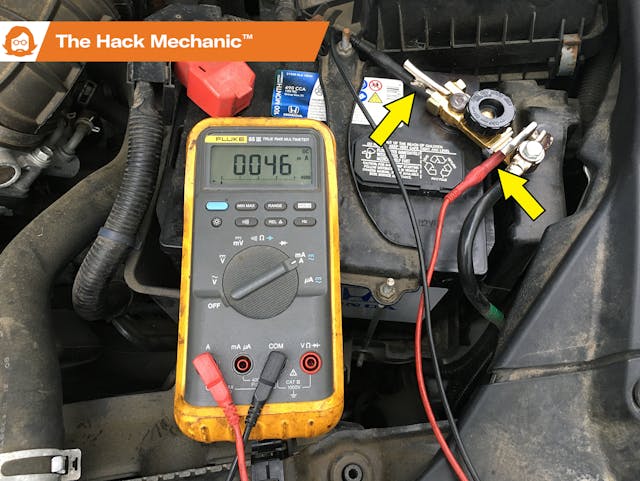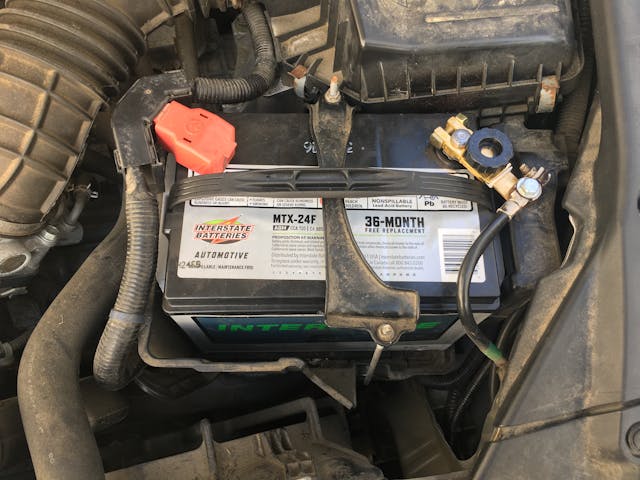How to drain a car battery, starring my 95-year-old neighbor’s daily driver

My next-door neighbor Jeanette is a 95-year-old woman. She’s healthy, independent, and pretty spry for her age. And she still drives—she uses her 21,000-mile 2012 Honda Accord to go to the grocery store, the hairdresser, and to the nursing home to visit her 102-year-old brother. Unfortunately, this past fall, the car began having a problem where, after not being driven for a few days, she’d come out to drive it and find that the battery was dead.
So-called “parasitic drains”—things that run the battery down while the car is sitting—can be a problem in any car, but they’re typically worse in newer cars. The electrical systems in cars without computers and onboard diagnostics are usually very simple, so unless there’s something like an aftermarket power antenna that’s perpetually trying to go up or down, there’s very little that remains on when the key is out of the ignition. If there is a problem, the time-honored method of dealing with it is to put a multimeter set to measure amperage between the negative battery cable and the negative terminal on the battery, measure the drain, then pull fuses out until it goes away and see what devices are on that fuse. If the devices listed in the owner’s manual for the fuse all appear to be behaving, you may need to unscrew the fuse box and examine the wires being powered by the mystery fuse, as sometimes someone has wired things, shall we say, creatively. But even still, the simplicity inherent in the car’s age makes it a very tractable problem.
However, as cars crossed into the 1990s, parasitic drains became much more difficult to diagnose. They can come from many different things: heated door locks, stuck central locking actuators, alarm systems, control modules that don’t go to sleep because the microswitches on the hood, and doors don’t think they’re closed … on and on.
And finding the cause is far more difficult than on an old car. While a vintage car might have only six or 12 fuses, a modern car typically has dozens, and systems may use more than one fuse. And because you need to get the control modules to go to sleep for the current levels to drop, you have to close the doors, hood, and trunk, or at least simulate their closure by either disconnecting the switches or rolling the latches closed. Then, instead of pulling fuses, you leave them installed and check the voltage drop across the back of each fuse to infer the current passing through it. Then you need to see what systems are on that fuse, but due to the complexity of those systems, you may need to consult a wiring diagram, which on modern cars is far more complicated than the old two-page foldout and instead often takes the form of a current track diagram. Like I said, a pain.
One of the best end-to-end videos I’ve seen of a professional mechanic doing this, where he methodically diagnoses the cause of a drain on a ninth-gen Civic to be a bad door lock actuator, can be seen here:
Watching it is instructive because it shows that, if the cause isn’t something simple like a dome or map light being left on (or the visor light not shutting off when its cover is flipped closed), or something laughable like an aftermarket seat heater being wired in, a comprehensive diagnosis is a beastly amount of work.
For this reason, if the drain is minor (e.g., if it drains the battery in days, not hours), many people simply live with it by either installing a battery cut-off switch or using a battery tender, maintainer, or trickle charger. As for me, I have too many cars to make trickle chargers practical (and besides, five of the cars are stored in a warehouse where there’s not easy access to electricity), so when I have cars sitting in storage for the winter, I simply disconnect the batteries. For cars that are in my driveway and driven only occasionally, I use battery cut-off switches.
Back to Jeanette’s battery-draining problem. It appeared to be getting worse; the car wouldn’t start after it had been sitting for about five days. She’d have AAA jump it. Eventually she took it to the Honda dealer. They tested the car’s two-year-old Honda-branded battery, said there was nothing wrong with it, and told her that she needs to drive the car more frequently and take it for longer drives on the highway. While there’s some truth to that, a) this is a problem that the car didn’t always have, and b) telling a 95-year-old woman who doesn’t drive on the highway that she needs to drive the car on the highway was neither terribly sensitive nor constructive. So, the battery kept running down, and she kept calling AAA. Eventually the problem happened enough that she used up her AAA benefit.
One morning she called me saying she had a hairdresser appointment in 30 minutes and the battery was dead. I checked it and found that it was down to 11.5 volts. I put it on charge and told her that, if necessary, I’d jump the car, but 30 minutes later it started. She asked, “What about if it dies when I want to drive home?” I said, “The hairdresser is two miles away. If that happens, call me and I’ll come and jump it.” (It was fine). I thought about saying, “I’ll just drive you to the hairdresser,” but you don’t mess with someone’s independence.
But the next week, she called me one morning in tears, saying that her brother had fallen in the nursing home, she needed to go see him, the car wouldn’t start, and she didn’t know what to do.
A few weeks ago, I wrote a piece about why working on other people’s cars is often a bad idea, but if I can’t help my 95-year-old neighbor out with a dead battery, I’m not, well, me. So, into the valley of the parasitic drain rode the man with the white hat.
The approach I use for this is four-fold. First, is there an obvious smoking gun? Second, is the alternator charging the battery? Third, is the battery obviously bad? Fourth, is there a measurable drain that’s above an acceptable limit?
I put a jump-pack on the battery and examined the car. I found no parking or interior lights on, and there was nothing plugged into the cigarette lighter socket (they’re not on without the key turned anyway; more on that in a moment). OK, so no smoking gun.
I jump-started the car and tested the voltage at the battery with a multimeter set to measure voltage. It read 14.3 volts, indicating that the alternator and its internal regulator were correctly charging the battery. This verified that whatever was going on wasn’t due to the alternator not charging the battery, as was the case recently with both my 2003 BMW 530i and my 1996 Winnebago Rialta.
Next, I tested the battery. I have a nifty little Cen-Tech digital battery analyzer I bought from Harbor Freight about eight years ago. There are now many similar products available on Amazon for as low as $30. These are referred to as “battery testers” or “load-testers,” but they don’t actually put a big load on the battery like an old-school carbon pile tester. Instead, they infer battery condition by conducting what’s essentially a resistance measurement across the terminals. On the Cen-Tech, if the reading is less than 5 milliohms, the battery is in very good condition. If it’s over 10, it’s toast. If it’s in the middle, it’s a gray area. I’ve found that this reading correlates well with the battery’s behavior—that is, batteries that don’t hold a charge have high resistance readings and vice versa.
I fully charged the Accord’s two-year-old Honda battery, tested it with the Cen-Tech, and found the reading to be about 6.5 milliohms—slightly higher than a new battery, but not awful. The analyzer also showed the battery to be at nearly 90 percent of its original 490 CCA capacity. So, at worst the battery was slightly weak, but there was nothing glaringly wrong with it.

With the alternator working fine and the battery not obviously bad, I took a direct current drain measurement. While you can just set a multimeter to measure amperage and put it between the negative battery post and its cable, it’s best if you do this with a $10 battery disconnect switch, as this method eliminates the big amperage surges that can come with directly connecting a multimeter and having all the current of the car’s electrical system suddenly flow through it. To do this, you:
- Install the disconnect switch on the negative side of the battery.
- Make sure the switch is engaged (is on). This forces any startup current to flow through the switch and not through the meter.
- Set the multimeter to measure DC current and connect it across the switch as shown in the photo below.
- Flip the switch to disengage it (to shut it off). This forces all current to flow through the meter, generating a reading. Remember that, in this configuration, you want to measure ONLY parasitic drain. You do NOT want to see what the drain is with lots of devices turned on, as that can easily exceed the limit of the multimeter. If the meter has a fuse, that can blow it. If it doesn’t, it can blow up the meter. WHATEVER YOU DO, DON’T TRY TO START THE CAR!
- Lock the car, as this is usually necessary to get the control modules to go to sleep.
- Watch the meter. You’ll probably see a current surge of single numbers of amps as the central locking actuates, then see it drop into the hundreds of milliamps as the interior lights wait to go out. Some amount of time later, the readings should drop into the tens of milliamps as the control modules go to sleep. This may take a few minutes or may be as long as 40 minutes. It varies by make and model. To find out what it is for your car, you may need to do some reading in a user’s forum.
In my case, within a very short amount of time after locking Jeanette’s car, the reading stabilized at a little under 50 milliamps.

If you don’t have a feel for amperage, you can convert it to the more familiar unit of watts with watts = amps x volts. The car has a 12-volt electrical system, so something drawing five amps is consuming 60 watts of power. You know what a 60-watt bulb is. Now you know that it would draw 5 amps. That’s a lot of current. In the world of parasitic drains, a drain of several amps is really big, and likely caused by something that’s actually generating heat, like an actual heater, a bright light bulb, or an electric motor. A drain of hundreds of milliamps could be something like a small bulb (a little 5-watt bulb would draw about .42 amps, or 420 milliamps), or a stuck actuator.
Now, the oft-quoted industry standard for an “acceptable” parasitic drain is 50 milliamps. So … was anything actually wrong with Jeanette’s car? It was difficult to say. It would’ve almost been preferable had I seen a much bigger drain that clearly indicated a problem.
I really wasn’t sure how to deal with it. This wasn’t my car. I didn’t have the room in my garage to do the hours of work required to try to diagnose it further, and I wasn’t certain that the thing to do was have Jeanette spend hundreds of dollars having a qualified shop chase a drain that might not be of much consequence, even if a problem existed. Yet the battery was draining sufficiently after four or five days that it caused the car not to start.
So, what followed was an odd sequence of bumping my head into the wall of why the normal workarounds appear to be to be unworkable.
I’d already installed a battery disconnect switch to enable me to properly do the drain measurement. If this were my car, that would’ve already solved the problem—I’d simply open the hood and flip the switch when I park the car in the driveway, then repeat the process when I need to drive it. But it’s simply not reasonable to expect a 95-year-old non-car-nut owner to do that.
The next obvious idea was to set her up with some sort of a battery tender or maintainer. On paper, this sounds like a slam-dunk. Unfortunately, she doesn’t park the car in her garage in the winter, as her driveway slopes slightly downhill and she doesn’t want the danger of slipping during that walk. There is an electrical outlet on the lamp post at the top of the driveway. This was what I used to charge the battery. I thought that if I set up a trickle charger there and could plug it into the Accord’s cigarette lighter socket, she’d be all set; all she’d need to do was disconnect the trickle charger from the extension cord to the lamp post.
But there was a two-fold issue with that. First, the cigarette lighter socket in the Accord isn’t active unless the key is turned to the accessories setting, so it would need to be connected to the battery instead. Like with the battery disconnect switch, I’m not going to ask her to open and close the hood whenever she needs to drive. Yes, I could permanently wire a little pigtail to the battery and have it protrude through the front grille (and I may do that, as I did with the disconnect switch, simply to make things easier on me when I help her out), but that brings us to the second problem, which is that one of the times I had the charger briefly hooked up, I watched her nearly trip over the cables. So even if she can plug and unplug a connector whenever she uses and parks the car, I’m very leery of anything that puts wires in her driveway.
Bottom line: I am not going to do anything that even slightly increases the possibility of a 95-year-old woman hurting herself. As health care professionals say, “First, do no harm.”

So, even though the battery wasn’t obviously bad, I replaced it—I got her a high-quality Interstate MTX-24F absorbed glass mat (AGM) battery with a 710 CCM rating. I’m hoping that the combination of the battery’s newness, 45 percent more capacity (at least in terms of cold cranking amps), and its AGM construction will buy the ability for to it sit for longer and behave better. At $229.95 ($242 with tax) directly from Interstate, it’s the most I’ve ever paid for a battery. (To be clear, she reimbursed me.)
[Quick digression: Costco has slightly discounted prices on Interstate batteries, and I got excited when I saw online that they offered the Costco version of this battery for $180, but on calling my local store, I learned that for some reason, Costco no longer carries Interstate AGM batteries. A web search unearthed a number of posts from folks who’ve had this same disappointment.]

A friend of mine had the interesting idea of installing a battery-charging solar panel and leaving it on the back deck under the rear windshield. The idea is that this would eliminate any driveway wires to trip over or connectors to unplug. It wouldn’t be as reliable as a trickle charger or battery tender, but any battery charging it would supply would be better than nothing. If the cigarette lighter socket was active without the key, this would be a great solution. Without that, I’d need to wire it in place, preferably directly to the battery, and I’m a bit hesitant to do that in a car that isn’t mine. But I’m thinking about it.
In the meantime, I’ll check the battery voltage weekly and see how much it’s dropping. And I’ll make some calls to find a local garage who knows how to perform proper parasitic drain diagnostics. Just in case.
Sometimes we simply wind up being responsible for certain things. Helping my 95-year-old neighbor remain independent by making sure the battery in her car stays charged isn’t a big deal to me. But as my mother used to say, what isn’t a big deal to you might be a big deal to someone else.
***
Rob’s latest book, The Best of The Hack Mechanic™: 35 years of hacks, kluges, and assorted automotive mayhem is available on Amazon here. His other seven books are available here on Amazon, or you can order personally inscribed copies from Rob’s website, www.robsiegel.com.
Check out the Hagerty Media homepage so you don’t miss a single story, or better yet, bookmark it. To get our best stories delivered right to your inbox, subscribe to our newsletters.


Battery drain is a slow tedious process some times. I have a trickle charger on one car for this issue as figuring out which item is doing the drain is very time consuming.
In my Model A, I wired a battery cutoff switch and installed it in the seat pedestal, where it can be reached from the driver’s seated position. But of course in a Model A, the battery is under the driver’s feet so the wiring wasn’t that complicated.
Much more importantly, though, you’re a mensch for taking care of your neighbour. That’s the real reason I enjoy reading your articles, Rob.
So the control modules will be pulling a little power all the time if you leave your car unlocked?
Great article, Rob. Informative and inspiring. Plus, it’s just plain fun to help people. Thanks for being Rob.
Great article! If it were my car I would have installed a kill switch under the dash, fairly easy to do. I understand you not wanted to run a fat wire thru your neighbors firewall, but worst case scenario it’s an option and she just has to flip a switch, forget opening the hood. Btw, can you let me know if that car goes up for sale??
I noticed no one has mentioned alternator diode leakage. My mother had the problem of a dead battery after not driving the car for a week or so. I tract the leak to the alternator diodes, to low resistance to ground. The alternator will still charge the battery when engine is running, however will drain the battery over time not running. This was a 1969 Buick 350, I also had a similar problem with a 1968 Ford 390. Look out for rebuilt alternators, measure reverse resistance on replacement units.
You beat me to this one. Think disconnecting the wires and seeing if the loss stops is the first step. Been years, but think there are several diodes, not just one.
In the mid 1990’s I was a Cadillac Service Manager. We had a customer with a 1995 or 1996 Sedan De Ville that had a battery drain issue. The car was still in new-car warranty. We had the car towed in at least 5 different times with a dead battery. Finally after one tow the customer mentioned when he went to a restaurant the CD player was on a different song when he came out after eating. Turns out the car had an aftermarket remote CD player in the trunk that had been wired direct-not thru the ignition. When the car was turned off the CD player motor continued turning untill the battery was dead. When the battery died the CD player turned off by itself. Simple rewire and all-ok !
I would start looking at the fuse box and see what the draw is on different circuits while the ignition is off. That may help isolate it. It could be something crazy like an engine immobilizer relay.
I have an 03 BMW 530i with that very problem! Among others! I’m going to try that disconnect switch routine and hopefully find my problem. I hope it’s not under the front passenger side floor. First I have to try to clear my sunroof drains and stop the water intrusion. I’m 75 and love driving this car but sometimes feel the plastic is crumbling around me. Fortunately it’s daily driver. Fun to work on and hope I can get this sorted out. 206k is just a blip for this car if you can do most of the repairs yourself. Except for the plastic parts. Thanks!
Kudos to you Rob for helping your neighbor with a car problem. I used to do this sort of this a lot more when I was younger and less concerned with liability. I’ll assist with simple stuff now, batteries, tire inflation and such, but complex repairs and parts replacements are ‘right-out’ at this stage of my life, and my own car herd is too large to get wrapped up in any of my neighbor’s stuff.
One additional test I like to run in these situations is an in-vivo alternator load test, you can do this without removing the alternator and toting it to the auto parts store.
1. Start by measuring the battery terminal voltage with your DVM while the engine is off, and with no loads, usually you’ll see about 12.5V at this step.
2. Start the engine and verify that the alternator is charging, you should see ~14.5 volts at idle.
3. Keep you DVM on the battery terminals and start adding loads. There are plenty of good loads built right into the car: Running lamps, headlamps, rear window defrosters (20A or more), cabin HVAC fan (these can pull 30A on high speed), if the engine is running and hot, the electric radiator fan cycling can be a 20 to 30A pull. Turn it all on in steps and keep watching the DVM.
4. If the battery terminal voltage drops below the engine off measured voltage, the alternator isn’t keeping up with the added electrical loads, and the battery is discharging.
5. If the alternator isn’t keeping up, try bringing the engine up to about 2,500 RPM and hold it there, see if it recovers. If it doesn’t, the alternator is probably faulty.
I’ve found alternators with one or two bad diodes this way, and a typical 3-phase alternator with one bad diode is down about 30% in ampacity, two bad diodes on different phases can drop its capacity by almost 70%.
Gary M.
Good job troubleshooting that issue.
Remote battery disconnect? Gives her a little remote dongle to connect/disconnect the battery, https://www.amazon.com/Disconnect-Upgraded-Wireless-Anti-Theft-Isolator/dp/B0B2CNQ2H6/ref=asc_df_B0B2CNQ2H6
Very informative and easy to follow…thank you!
What Fred said. I have a 2011 Accord that had the same symptoms. I hooked up my multimeter then disconnected the Bluetooth control module under the dash and bingo! Current drain dropped significantly. Apparently a very common problem in several years of Honda/Acura models. The module often still works so if your 95 year old neighbor must talk and drive at the same time then there’s a way to wire in a normally solenoid….
Normally closed.
I’ve had parasitic drains from older aftermarket car starters. Eventually they give out, like before I buy the car.